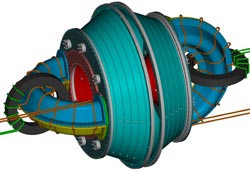Mug handles could help hot plasma give lower-cost, controllable fusion energy

T. Jarboe, Univ. of Washington<br><br>A computer drawing of the prototype, which attaches current-carrying handles to either end of the central plasma.<br>
A new finding from the University of Washington could help contain and stabilize the plasma using as little as 1 percent of the energy required by current methods.
“All of a sudden the current energy goes from being almost too much to almost negligible,” said lead author Thomas Jarboe, a UW professor of aeronautics and astronautics. He presents the findings this week at the International Atomic Energy Association’s 24th annual Fusion Energy Conference in San Diego.
The new equipment looks like handles on a coffee mug – except they attach to a vessel containing a million-degree plasma that is literally too hot to handle.
Most people know about nuclear fission, the commercial type of nuclear power generated from splitting large atoms in two. Still under research is nuclear fusion, which smashes two small atoms together, releasing energy without requiring rare elements or generating radioactive waste.
Of course, there’s a catch – smashing the atoms together takes a lot of energy, and scientists are still working on a way to do it so you get out more energy than you put in. The sun is a powerful fusion reactor but we can’t recreate a full-scale sun on Earth.
An international project in France is building a multibillion-dollar fusion reactor to see whether a big enough reactor can generate fusion power.
The reactor in France will inject high-frequency electromagnetic waves and high-speed hydrogen ions to sustain the plasma by maintaining an even hotter 100-million-degree operating temperature and enclosing it with magnetic fields.
“That method works,” Jarboe said, “but it’s extremely inefficient and expensive, to the point that it really is a major problem with magnetic confinement.”
For two decades Jarboe’s team has worked on helicity injection as a more efficient alternative. Spirals in the plasma produce asymmetric currents that generate the right electric and magnetic fields to heat and confine the contents. Plasma is so hot that the electrons have separated from the nuclei. It cannot touch any walls and so instead is contained by a magnetic bottle. Keeping the plasma hot enough and sustaining those magnetic fields requires a lot of energy.
“We would drive it until it was unstable,” Jarboe said of his approach. “Like you twist up a rope, the plasma twists up on itself and makes the instability and makes the current drive.”
Results showed the UW strategy required less energy than other methods, but the system was unstable, meaning that if conditions change it could wobble out of control. It’s like a stick balancing on one end, which is stable at that moment, but is likely to come crashing down with any nudge. In the case of plasma, unstable equilibrium means that a twist in the plasma could cause it to escape and potentially lead to a costly reactor shutdown.
Instability was a major impediment to applying the UW method.
“The big issue is whether, when you distort the bottle, it will leak,” Jarboe said.
By contrast, in a stable equilibrium, any shift will tend to come back toward the original state, like a ball resting at the bottom of a bowl that will settle back where it started.
“Here we imposed the asymmetric field, so the plasma doesn’t have to go unstable in order for us to drive the current. We’ve shown that we can sustain a stable equilibrium and we can control the plasma, which means the bottle will be able to hold more plasma,” Jarboe said.
The UW apparatus uses two handle-shaped coils to alternately generate currents on either side of the central core, a method the authors call imposed dynamo current drive. Results show the plasma is stable and the method is energy-efficient, but the UW research reactor is too small to fully contain the plasma without some escaping as a gas. Next, the team hopes to attach the device to a larger reactor to see if it can maintain a sufficiently tight magnetic bottle.
The research is funded by the U.S. Department of Energy. Co-authors are Brian Nelson, research associate professor of electrical engineering; and research associate Brian Victor, research scientists David Ennis, Nathaniel Hicks, George Marklin and Roger Smith and graduate students Chris Hansen, Aaron Hossack, Cihan Ackay and Kyle Morgan, all in UW aeronautics and astronautics.
For more information, contact Jarboe at 206-685-3427 or jarboe@aa.washington.edu.
His presentation will take place Saturday, Oct. 13, at 11:05 a.m. in the Indigo Ballroom of the Hilton San Diego Bayfront Hotel, in the Innovative Confinement Concepts track.
Media Contact
More Information:
http://www.uw.eduAll latest news from the category: Power and Electrical Engineering
This topic covers issues related to energy generation, conversion, transportation and consumption and how the industry is addressing the challenge of energy efficiency in general.
innovations-report provides in-depth and informative reports and articles on subjects ranging from wind energy, fuel cell technology, solar energy, geothermal energy, petroleum, gas, nuclear engineering, alternative energy and energy efficiency to fusion, hydrogen and superconductor technologies.
Newest articles

Silicon Carbide Innovation Alliance to drive industrial-scale semiconductor work
Known for its ability to withstand extreme environments and high voltages, silicon carbide (SiC) is a semiconducting material made up of silicon and carbon atoms arranged into crystals that is…

New SPECT/CT technique shows impressive biomarker identification
…offers increased access for prostate cancer patients. A novel SPECT/CT acquisition method can accurately detect radiopharmaceutical biodistribution in a convenient manner for prostate cancer patients, opening the door for more…

How 3D printers can give robots a soft touch
Soft skin coverings and touch sensors have emerged as a promising feature for robots that are both safer and more intuitive for human interaction, but they are expensive and difficult…





















